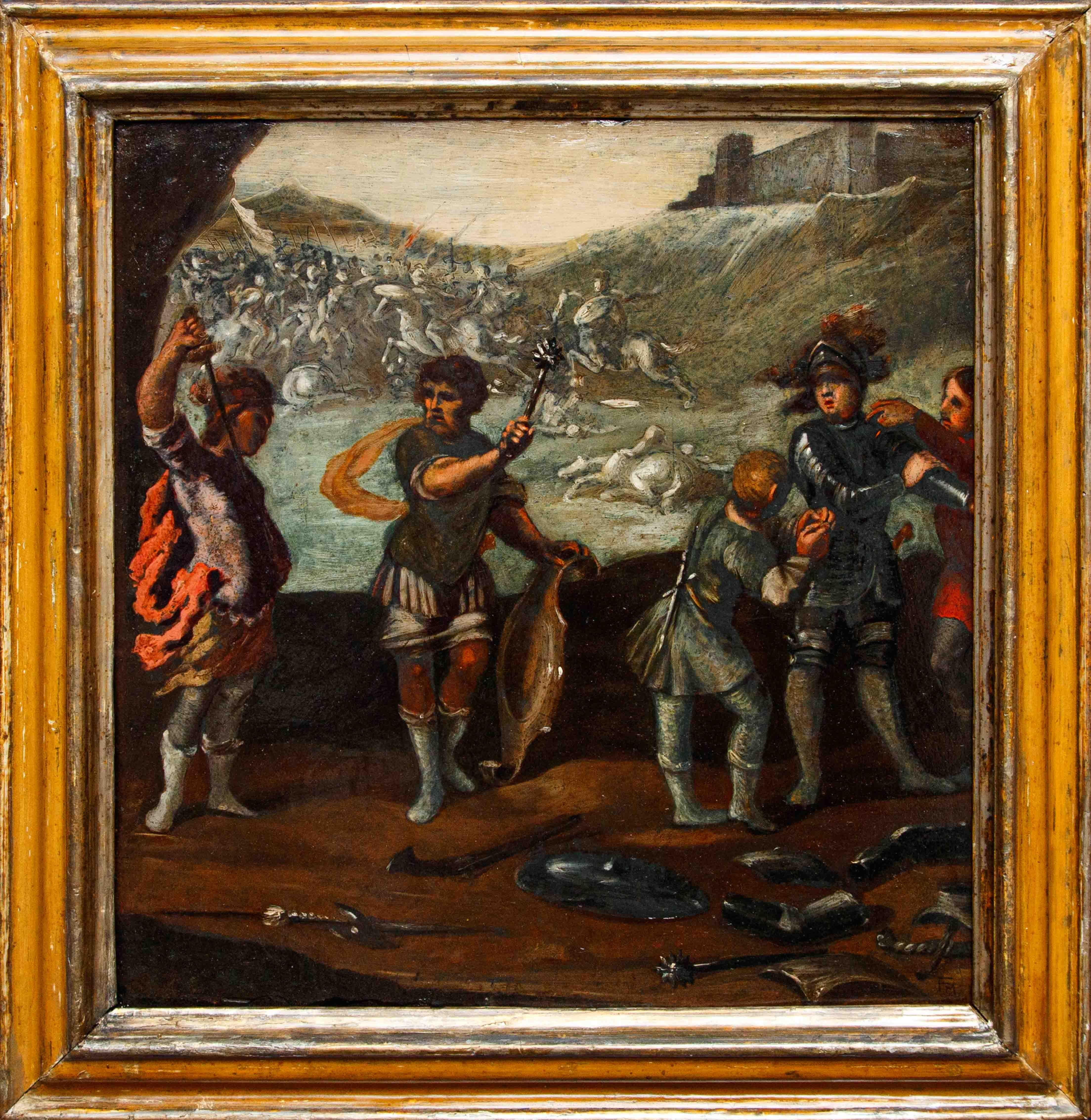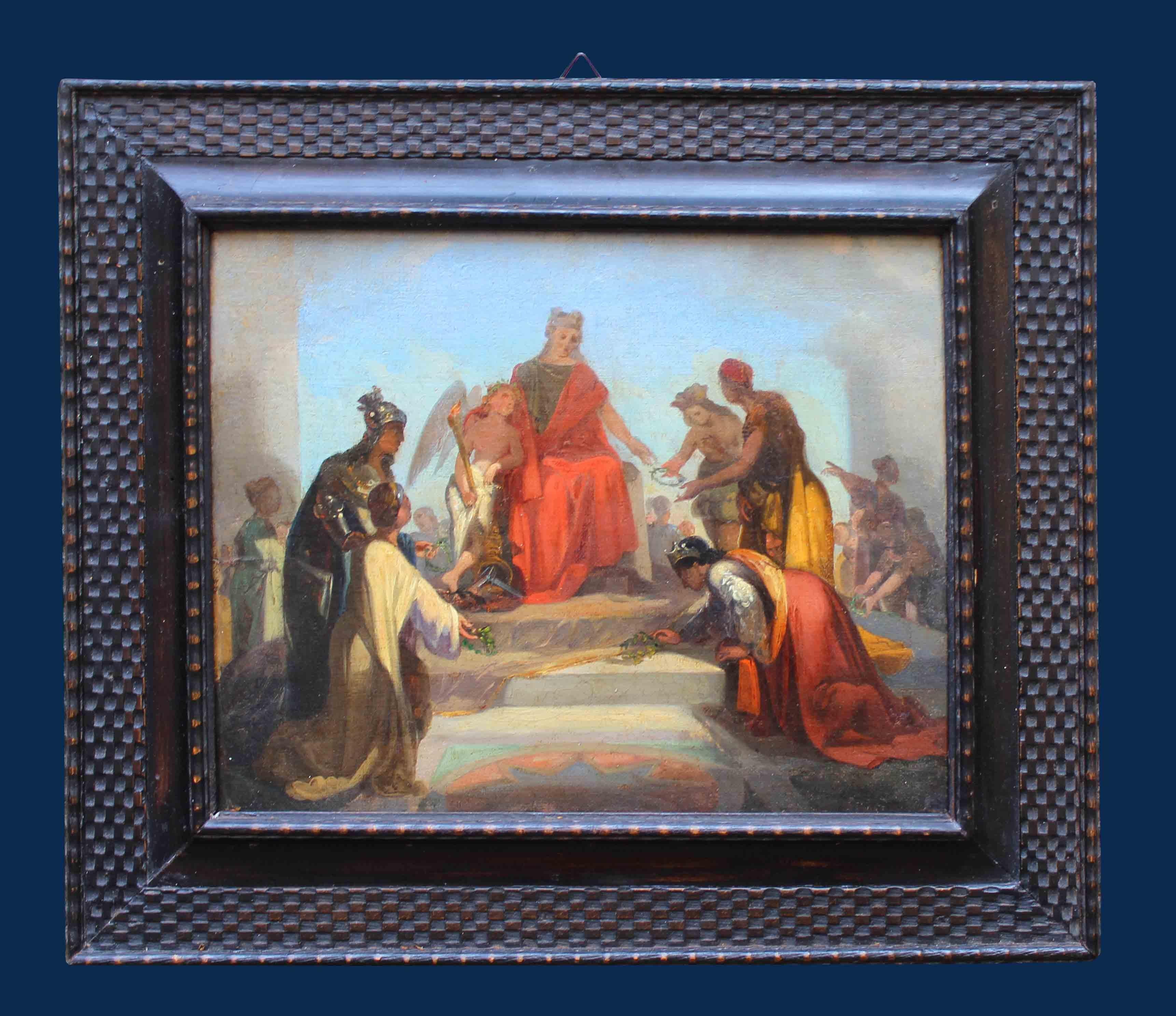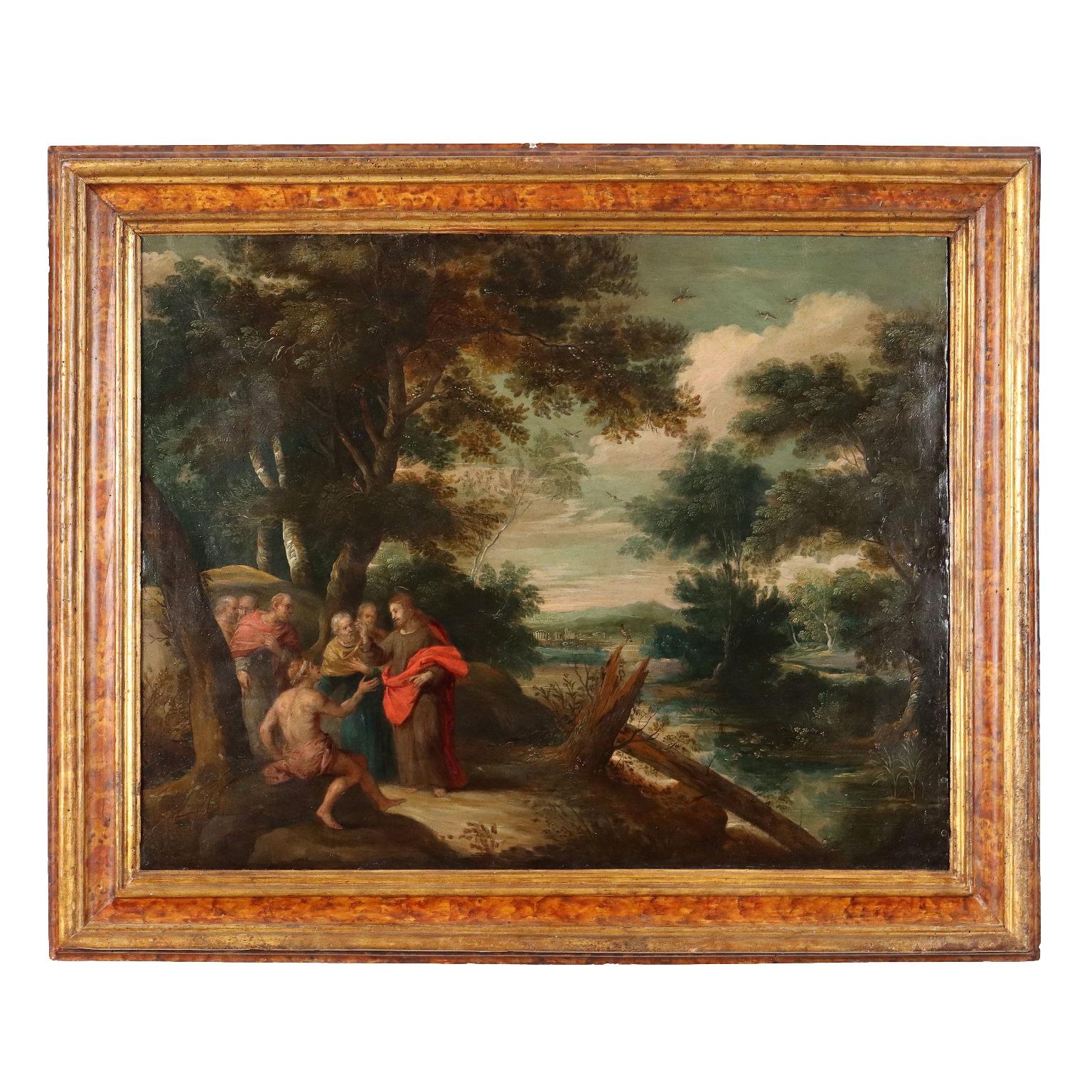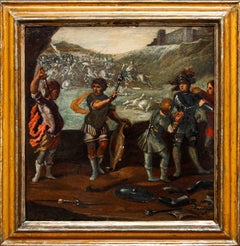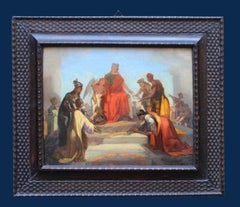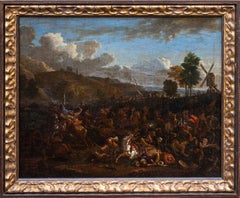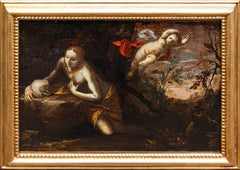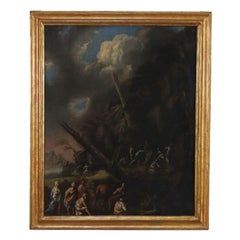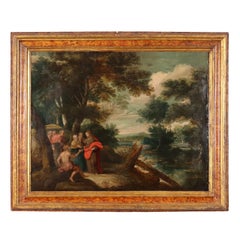Items Similar to Follower of Jacques Caillot, first half of the 18th century Ascent to Calvary
Want more images or videos?
Request additional images or videos from the seller
1 of 12
Follower of Jacques Caillot, first half of the 18th century Ascent to Calvary18th 18th Century
18th 18th Century
$9,280.32
£6,946.35
€7,800
CA$12,746.75
A$14,252.43
CHF 7,475.99
MX$172,631.13
NOK 94,369.72
SEK 89,156.58
DKK 59,383.66
About the Item
Follower of Jacques Caillot, first half of the 18th century
Ascent to Calvary
Oil on oak panel, 33 x 48 cm
With Frame, 54 x 67 cm
The painting is not signed
Legend tells of a young man of noble spirit, Jacques Callot, who, driven by an irrepressible passion for the fine arts, disdained the comforts of a wealthy home to pursue the dream of Rome, cradle of the muses. Twice, in defiance of his father's authority, he left his native roof to travel to the court of the Duke of Lorraine, where the expectation of a life more in keeping with his artistic ideals enticed him. Callot's career is divided into an Italian period (c. 1609-21) and a Lorraine (France) period (from 1621 until his death). In 1608 he was in Rome, under the expert guidance of engraver Philippe Thomassin; here the young Callot began to refine his technique, devoting himself to reproducing majestic works, jealously guarded in the sacred abodes of the Eternal City. With almost painstaking acumen, he immersed himself in the study of the Flemish masters and the refined Mannerists, absorbing their style and mastery. His artistic career experienced an unexpected heyday in 1612, when he was enthusiastically welcomed to the sophisticated Medici court in Florence. In that environment of exquisite elegance, Callot's talent found fertile ground. With an incisive stroke and unparalleled wit, he brought to life a nuanced work, portraying scenes of everyday life with startling veracity: boisterous fairs, opulent feasts, representations of the commedia dell'arte, grotesque figures and beggars, vain courtiers and twisted-faced hunchbacks. After the death of Duke Cosimo II in 1621, Callot returned to Nancy, where, in the service of the Lorraine court, he continued to paint and engrave, shaping imaginative visions and scenes of everyday life. Unfortunately, most of his pictorial works have been lost, leaving us with only an echo of his extraordinary abilities. In Nancy, the artist deepened his artistic research, tackling more challenging and mature themes. Alongside depictions of mundane life, he devoted himself to religious subjects, compositions depicting the horrors of war, and landscapes of poignant beauty. In 1633, deeply shaken by the wartime events rocking Europe and Cardinal Richelieu's invasion of Lorraine, Callot produced a series of engravings strongly denouncing the atrocities of war called Les Grandes Misères de la guerre, consisting of 18 prints published in 1633. His works, charged with raw and painful realism, anticipate Goya's famous "Disasters of War" by nearly two centuries, revealing a sensitivity and capacity for psychological analysis that place him among the greatest artists of his time. Caillot was able to develop a naturalistic style while retaining the artificiality of the occasion, organizing a composition as if it were a stage and reducing the figures to a tiny scale, each indicated by the fewest possible strokes. This required a very fine engraving technique. His breadth of observation, vivid figure style, and ability to gather a large, moving crowd ensured for his etchings a lasting popular influence throughout Europe. The splendid plate presented here is the most faithful version of the engraving made by Jacques Caillot of the same subject. Each element is faithfully captured with skill and expertise.
- Creation Year:18th 18th Century
- Dimensions:Height: 13 in (33 cm)Width: 18.9 in (48 cm)
- More Editions & Sizes:cm 33 x 48Price: $9,280
- Medium:
- Circle Of:Jacques Callot (1592 - 1635, French)
- Period:
- Condition:
- Gallery Location:Milan, IT
- Reference Number:1stDibs: LU2639216608372
About the Seller
No Reviews Yet
Vetted Professional Seller
Every seller passes strict standards for authenticity and reliability
1stDibs seller since 2023
Typical response time: <1 hour
- ShippingRetrieving quote...Shipping from: Milan, Italy
- Return Policy
Authenticity Guarantee
In the unlikely event there’s an issue with an item’s authenticity, contact us within 1 year for a full refund. DetailsMoney-Back Guarantee
If your item is not as described, is damaged in transit, or does not arrive, contact us within 7 days for a full refund. Details24-Hour Cancellation
You have a 24-hour grace period in which to reconsider your purchase, with no questions asked.Vetted Professional Sellers
Our world-class sellers must adhere to strict standards for service and quality, maintaining the integrity of our listings.Price-Match Guarantee
If you find that a seller listed the same item for a lower price elsewhere, we’ll match it.Trusted Global Delivery
Our best-in-class carrier network provides specialized shipping options worldwide, including custom delivery.More From This Seller
View AllAttributed to Francesco Montelatici called Cecco Bravo, dressing of the knight
Located in Milan, IT
Francesco Montelatici called Cecco Bravo (Florence, November 15, 1601 - Innsbruck, December 1661), attr.
Dressing of a knight before battle
Oil on slate, 48 x 47 cm
Framed, 60 x 5...
Category
17th Century Other Art Style Figurative Paintings
Materials
Stone
Attributed to Hannibal Gatti, Allegorical Scene
By Annibale Gatti
Located in Milan, IT
Annibale Gatti (Forlì 1827 - Florence 1909), attr.
Allegorical Scene
Oil on paper applied to board, 25 x 30 cm - with frame 36 x 42
The allegorical work, by analysis and stylistic...
Category
19th Century Other Art Style Figurative Paintings
Materials
Paper, Oil
Battle scene Oil painting on canvas Attributed to Karel Breydel
By Karel Breydel
Located in Milan, IT
Attr. to Karel Breydel, known as the Knight of Antwerp (1678 - 1733)
Battle with knights and landscape in the background
Oil on canvas, cm 44.5 X 36.7
Frame 52.5 x 45 cm
The pain...
Category
Late 18th Century Figurative Paintings
Materials
Canvas, Paint, Oil
By Giovanni Stefano Danedi, known as Il Montalto
Located in Milan, IT
Giovanni Stefano Danedi, known as Montalto (Treviglio, 1612 - Milan, 1690)
Penitent magdalene
Oil on panel, 34 x 45 cm
Framed, 44 x 57 cm
Provenance: Giancarlo Sestieri Collecti...
Category
17th Century Other Art Style Figurative Paintings
Materials
Oil
Karl Breydel, called The Knight of Antwerp (Antwerp, 1678-1733), Battle
Located in Milan, IT
Karl Breydel, called The Knight of Antwerp (Antwerp, 1678-1733)
Battle scene between Christians and Turks
Oil on canvas, 28.5 x 41 cm
The painting under consideration, consideri...
Category
Mid-17th Century Other Art Style Figurative Paintings
Materials
Canvas, Oil
Lambert de Hondt I (1620-1652), Battle Scenes
Located in Milan, IT
Lambert de Hondt I (1620-1652)
Battle scenes
(2) Oil on panel, 18 x 13 cm
Signature in the bottom middle
The figures of knights and soldiers in the work under consideration are ...
Category
17th Century Other Art Style Landscape Paintings
Materials
Oil, Board
You May Also Like
Painting The Preaching of St. John the Baptist, 17th-18th century
Located in Milan, IT
Oil on Canvas. North Italian school of the 17th-18th centuries.
The large scene is filled with figures in ancient Eastern garb, set in a northern, richly vegetated landscape with mou...
Category
Late 17th Century Other Art Style Figurative Paintings
Materials
Oil
Painting Moses Makes Water Flow from the Rock XVII-XVIII century
By Giovanni Ghisolfi
Located in Milan, IT
Oil on Canvas.
Set in a classical, richly vegetated landscape, the scene depicts the biblical episode from the book of Genesis that tells how the people of Israel, who are crossing t...
Category
17th Century Other Art Style Figurative Paintings
Materials
Oil
Painting Moses Saved by the Waters, 17th-18th century
Located in Milan, IT
Oil on Canvas.
The scene recounts the biblical episode from the book of Exodus in which baby Moses, whom his mother had entrusted to the river inside a basket to save him from the s...
Category
Late 17th Century Other Art Style Figurative Paintings
Materials
Oil
Painting with a Healing Scene 17th Century
Located in Milan, IT
Oil on copper. Flemish school of the seventeenth century.
The painting, attributed by oral tradition to Frans Francken the younger (1581 -1642), depicts a miraculous healing perform...
Category
17th Century Other Art Style Figurative Paintings
Materials
Oil
Gallant party in the park. French School. Mid-18th century
Located in Milan, IT
The scene depicts a feast within a park enclosed by walls with arched gateways opening onto the countryside, and adorned on the right with an amphora on a small column and in the center, behind the figures, with a gushing fountain, with statues of cherubs and shells.
Two couples of richly dressed ladies and gentlemen entertain themselves gallantly, surrounded by servants; one of the men is playing the violin, crouching in front of his lady, who, flanked by the damsel, follows the melody on the score held up by the dark-haired man at her side, while two musicians accompany the playing with flute and a mandolin; the other couple, in an attitude of intimate dialogue, listens on the left, while on the right the hunter returning from the hunt also observes the scene.
Particularly prominent in the scene is the rich dress of the lady in the center, characterized by the wide back folds falling from her shoulders to create a cape. Such a dress corresponds to what was called "robe à la Watteau," named after the French painter Antoine Watteau who first portrayed ladies wearing this pattern.
Antoine Watteau (1684 -1721), a French painter considered one of the most influential French exponents of Rococo painting, was the forerunner of the pictorial genre of gallant scenes, a genre that developed in France from the late 1600s and continued throughout the following century.
The gallant scenes could be considered as the aristocratic version of the genre scene: characterized by music, dances, pleasant conversations between ladies and gentlemen surrounded by servants, they tended to enhance the costumes, fashionable clothes, and environments of the upper class, conveying a kind of detachment from the real times and places, projecting the viewer into an almost theatrical atmosphere of gestures, looks, colors and stage lights.
Moreover, Watteau, along with the Fêtes galantes cycles, also distinguished himself for those inspired by the theater, absorbing his passion for the scenes and characters of that milieu from Claude Gillot...
Category
Mid-18th Century Other Art Style Figurative Paintings
Materials
Oil
Painting Cain and Abel 17th-18th century
Located in Milan, IT
Oil on Canvas. Northern-Italian school of the 17th-18th centuries.
The widely known biblical scene of the quarrel between the two brothers, sons of Adam and Eve, which later results ...
Category
Late 17th Century Other Art Style Figurative Paintings
Materials
Oil
